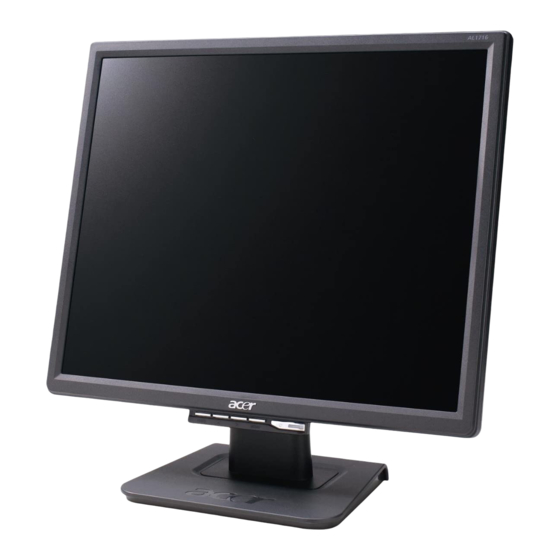2.1 General Information
HannStar, HSD170MGW1-A00 which display model
is a color active matrix thin film transistor (TFT) liquid
crystal display (LCD) that uses amorphous silicon TFT
as a switching device. This model is composed of a
TFT LCD panel, a driving circuit and a back light
system. This TFT LCD has a 17.0 inch diagonally
measured active display area with XGA resolution (900
vertical by 1440 horizontal pixel array) and can display
up to 262,144 colors.
2.2 Panel Timings:
The controller included with the monitor shall translate
all video timings from the CPU that meet the timing
requirements listed in panel specification into timings
appropriate for the panel. Under no circumstances
may the controller supply the panel with timings that
may result in damage. The controller shall insulate the
panel from the CPU, so that the panel shall always be
driven per it's own specification regardless of the
timings being sent from the CPU.
2,3 Polarizer Hardness:
The outer face of the front polarizer panel shall be
covered with a coating with a 3H hardness value.
2.4 Backlight Requirements:
2.4.1 General Requirements: The backlight assembly
shall be designed to support field replacement at
the customer site or authorized service center.
The lamps shall have a continuous operating life
of at least 30,000hrs at 25 degree C. The
operating life is defined as having ended when
the illumination of light has reached 50% of the
initial value. The lamps shall extend a sufficient
amount from the edge of the light guide that
sputtering over the life of the lamps shall not
cause degradation of the luminance uniformity
(such as non-illuminated bands along the edges
of the display).
2.4.2 Lamps Startup Time: The backlight lamps shal
start within 3sec. of the time the monitor power
switch is pressed or the monitor is restarted from
a power - down mode .The starting time shall stay
below 3 sec. for the minimum expected life of the
lamps. Test conditions are as follows:
Ambient Light ----------------------< 1.0 lux.
Temperature------------------------10degreeC
Inactive Time -----------------------> 24 hours
2. Flat Panel Specification
.
2.5 Defects:
2
.5.1 Visual Inspection: The LCD panel shall be
inspected with all pixels set to white, black, red,
green, and blue. The color variation, brightness
variation, and overall appearance must not be
perceived as poor quality by Lite - On. Areas and
/or parameters considered questionable shall be
subjected to detailed measurements.
2
.5.2 Display Degradation: Over the life of the product,
variation of the parameters specified in panel
specification shall be maintained within
reasonable limits. The panel must not exhibit any
significant defects while in operation (excluding
the CCFL operation). This does not in any way c
change the warranty given by the panel vender.
2
.5.3 Light Leakage: Except for the active display area,
there shall be no light emission visible from any
angle from any other part of the display. For this
test, the ambient illumination will follow the panel
specification 300 to 700 lux.
2
.5.4 Allowable Defects: No cosmetic defects are
allowed except those specified below. The
conditions of visual inspections are as follows:
- Viewing distance is to be approximately 35~50
cm.
- Ambient illumination is to be 300 to 700 lux.
- Viewing angle range shall be 160 degrees
Horizontal and 160 degrees vertical typically.
- Defects not apparent within one minute shall be
ignored.
2.5.5 Defect Terminology: Table 3 gives the descriptive
terms used in classifying defects.
Spots or lines that appear dark in the display patterns and are usually the
result of contamination. Defects do not vary in size or intensity (contrast)
Dark Spots/Lines
when contrast voltage is varied. Contrast variation can be achieved
through the use of varying gray shade patterns.
Spots or lines that appear light in the display patterns. Defects do not vary in
Bright Spots/Lines
size or intensity (contrast) when contrast voltage is varied. Contrast variation
can be achieved through the use of varying gray shade patterns.
When the unit lights, lines appear light (white) with display patterns dark and
Polarizer Scratch
do not vary in size. Physical damage to the polarizer does not damage the
glass.
When the unit lights, spots appear light (white) with display patterns dark
Polarizer Dent
and do not vary in size. Physical damage to the polarizer that does not
damage the glass.
Horizontal or diagonal lines that appear gray with the display patterns dark
Rubbing Line
and may have resulted from an 'out of control' rubbing process on the
polyimide or 'waves'" on the BEFs or prism sheets .
Newton Ring
The 'rainbow' effect caused by non-uniform cell thickness.
When the unit lights, variation / non – uniformity (splotchiness) appears light
Mottling
(white) with the display and might vary in size.
When the unit lights, line(s) in the minor (vertical) or major (horizontal) axis
Dim Line
appear dim, but not completely on or off.
Cross Lines Off
When the unit lights , lines in both the minor and major axis do not appear.
Bright/Dark Dot
A sub - pixel (R, G, B dot) stuck off / on (electrical).
7
ACER AL1716W
Go to cover page

